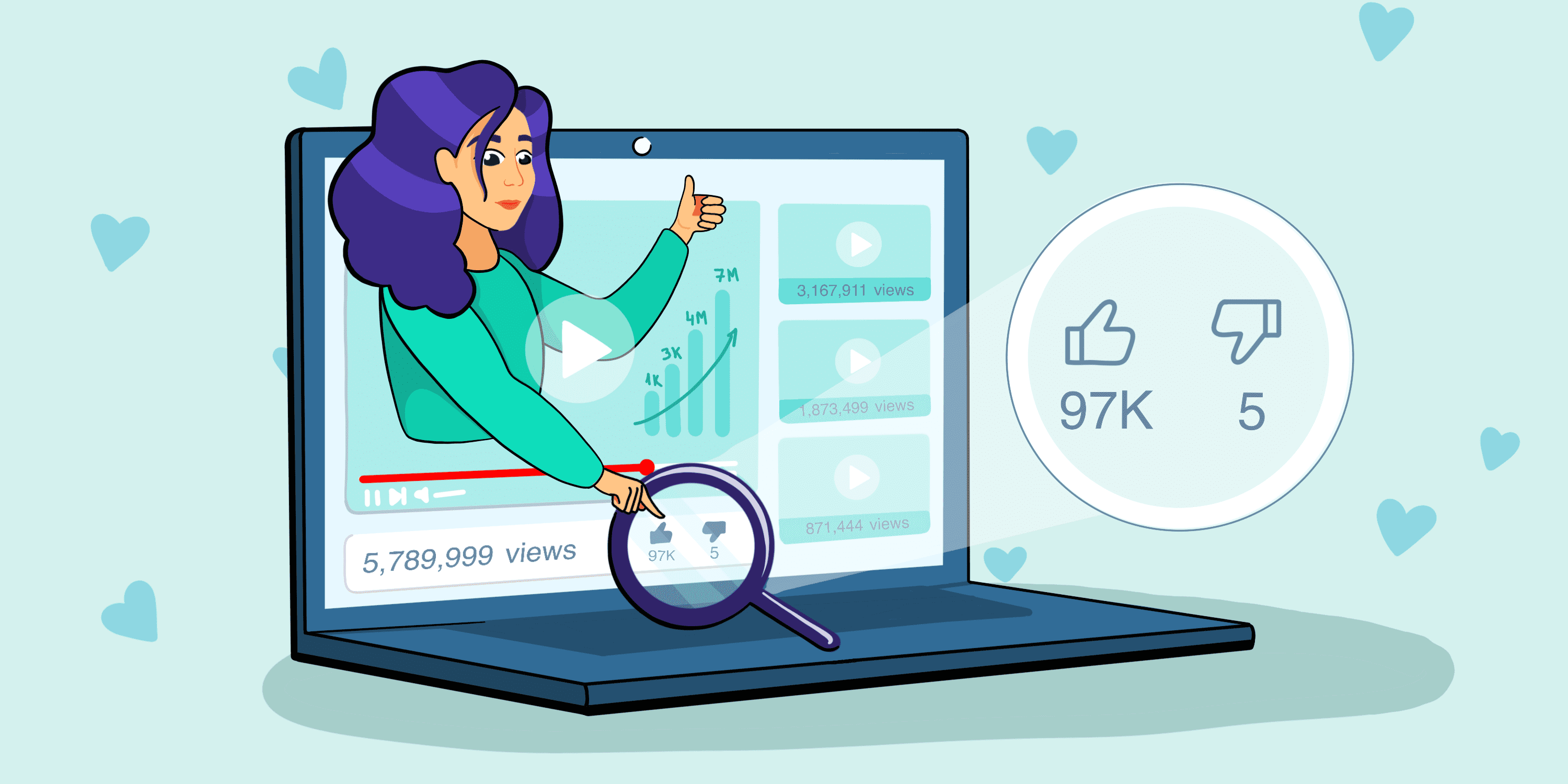How to Make Your Video the Most Viewed and Get Recommended

A lot of people believe that you can’t guess which video will go viral and get recommended. Perhaps, this is true. It is very hard to understand why some videos are well received, while on the surface it may seem to you that they should not be “popular” on YouTube.
Nevertheless, viral videos, or, so-called piggyback videos, have rules and patterns that contribute to their growth and their ability to get recommended on YouTube. In this article we will delve into the topic of popular videos: what elements inside the video motivate people to watch them and what is the secret of successful channels on YouTube?
What is a viral video and what is a "piggyback" video?
The term "piggyback" is a slang word that is used by YouTube creators when talking about videos that gain views and subscribers. In fact, such videos help to “pull” up the entire channel.
The more commonly used term you're probably familiar with is viral video. This type of content is “distributed by users through voluntary sharing it on their pages, and resources, as well as through the “share with a friend” feature. This is how Wikipedia characterizes viral content. Let's just add that this is always an extremely popular video, which over time people use to make memes out of it. The video can be both new and trendy or old, which has been sitting on the YouTube platform for years.
What is the difference between a viral video and a "piggyback" video?
To put it simply: a viral video is often a sharp and a sudden hit on trends. These types of videos are in most cases entertaining, can be relevant only in the moment and will fade away quickly. A sort of flash in the sky of YouTube.
A piggyback is a video that can be anything: both entertaining and educational. It becomes super popular only in comparison with the average number of views of the author's videos on his channel. The ‘piggyback’ may not have explosive growth, but it is still noticeable. Moreover, its popularity may start growing both immediately after uploading the video, and subsequently.
What is important for you to keep in mind? The bottom line about piggyback videos is the same as for viral videos - sooner or later they cease to grow. Although many times slower than the viral ones.
There is a myth that if some “unsuccessful” video is released on the channel, then it will negatively impact the entire development of the channel. And many YouTubers believe that a series of these "unsuccessful" videos, each of which gets fewer and fewer views, reduces impressions. It seems like YouTube punishes low-quality content.
But the truth is much more simple. If you make good, or even subpar quality videos, you will still have an opportunity to go viral. When you upload a video to a channel, YouTube will begin to analyze and promote it separately from all your previous content.
Sometimes when you upload a video it goes viral and people like it. But then all subsequent videos do not gain the same feedback. You may think that there is not much difference between these videos, but for your viewers, there is a difference: you’ve chosen a different topic, the quality of the video is different, or you just didn’t speak as excitingly as in what was recommended.
It also may be that your video was introduced to a new audience and grabs attention. It represents the author, but the viewers don’t feel like subscribing to the channel and watching the subsequent videos. Therefore, you end up with only one successful video. The problem is not with the algorithm, but with the viewers. After all, the platform relies on signals from viewers, and if there are no signals, there is no promotion.
Conclusion: anyone can create a viral video at any time, regardless of how long the channel has existed, how many videos there are, and how many good or bad ones you have there.
What helps videos go viral?
Let's be honest: most often videos don't succeed or they are not watched at all, because they are simply not interesting. This is where you should start. All viral videos are interesting, or at least weird, but certainly not boring.
Remember that you are providing value with your video in exchange for the viewer's time. Viewers won’t share their time if they are not engaged in your content.
The most valuable thing for a YouTube viewer is his altered state during and after watching. Namely: emotions, insights while watching, transformation after viewing. What has changed in his mind or his views on the subject matter.
If a person experiences one of the above from watching your video, then you have provided a great value exchange. Sometimes even a perfect video with value for the viewer can be hindered by some small thing, such as its length. That means, the video has value, but this value is not equivalent to the time a person has to spend watching it.
- One of the first criteria that will market you is thumbnails and titles. This will help trigger a potential viewer to click on your video.So make them enticing enough to prompt action.
Your video thumbnails must be bright to be able to arouse the viewer's curiosity. And it's always a fine line between curiosity and bewilderment, where you just seem weird instead of attractive. Although for some viewers it still works.
The main task of the thumbnail is that it should make the viewer stop scrolling and focus on your video. And the more looks the thumbnail gets, the more clicks and views you get. Most often, viral videos contain some kind of bright emotion and the face of the creator on their thumbnail.
People often watch videos that evoke emotions, so the thumbnail is the very first element that promises the viewer the desired response.
In some cases, it will be enough, but it will never be superfluous to add flashy text that will attract the attention of the viewer, “inflate” his curiosity, and create intrigue. Clicks are important for videos. The more YouTube recommends your videos, the more they get clicked on. And the more clicks, the more impressions ... - and so on to infinity.
- You should not forget about the first six seconds of your video. The start of the video must be catchy, otherwise, the audience will not even remain to see the main part of the video.
- Also, viral videos are more often based on content from comedy music, entertainment/pop culture, and “how to” categories. But that’s not the same with piggyback videos. Let's look at the example below.
Let's look back at one of the most popular series of the last decade, "Game of Thrones". The release of each new season was accompanied by a large number of different theories because the plot moved away from the history of the book. On the Google Trends chart, you can see that each new season caused a wave of videos on the platform. Everyone who skillfully rode this wave with their videos gained both virality and “piggybacked” off of the trend.
Now that the Game of Thrones hype has faded, it has been replaced by the series House of the Dragon. And if you release a video specifically for the second series, there is a great chance to go viral or begin to “piggyback” off of user interest.
As for all the viral videos that were created a long time ago, but at the right time, they have worked their way out and, most likely, “died” off in terms of promotion.
Perhaps, due to the release of the prequel (a film that tells the backstory of the events of the main film), they can still gain some traction in order to become piggybacks for a while, but this will also not last too long.
Important: if you create a truly viral video, then it dies faster than a piggyback video.
- Sometimes the length and specificity of viral video works as an advantage.
The shorter the video or the more specific the issue it addresses, the more likely it is to go viral. With “piggybacks” it’s different: they can be both short and long form. It all depends on how deeply you delve into a popular topic.
To make a one-time viral video that will succeed and bring you views and subscribers, you do not really need to stick to the topic and niche of your channel. But keep in mind that new viewers will not watch other videos. They will just be dead weight on your channel. And if there are no views, there are no impressions.
With "piggybacks" it’s a different story: these are exclusively niche videos. Moreover, they are about the popular topics in a niche. They must be creative and more useful than those of competitors, otherwise, they simply will not be able to compete with other videos.
Viral videos and "piggyback" videos can be repeated every year with some updates or improvements. For instance, you released a video about how to pay self-employment taxes on a channel about financial literacy, it became popular, and over the next year, the laws have already changed ten times. You have identified a trend that people start looking for answers to pressing questions by the end of the year, when all reports are due, and you come up with a similar video, with an update for the year and answers to all popular questions.
But you must keep in mind that some topics may never get a viral video at all, simply because the topic does not have audience interest.
How do you make sure that the topic is in demand? You should first research YouTube itself, see whether it is popular with viewers, and how long ago there were viral videos around this topic. The topic could be outdated and have lost its popularity, or it can be the other way around, it could have dropped off simply due to the lack of interesting videos and you will now inject life into the subject with fresh content.
In fact, YouTube provides clues itself. Just make sure to check out the main page and carefully look at what is in the line above the videos recommended to you.
- Let YouTube know who your target audience is. It makes no sense to talk about who your target audience is. There are many other articles and videos on this topic. Try to figure out how to show YouTube who your viewer is.
— Tags and descriptions (separate videos and channel as a whole): make sure to use keywords.
— Video titles. We should describe our videos in such a way that the YouTube algorithm and a regular viewer would equally understand them. If you write only for viewers, you will miss the SEO opportunities, and if you only write for YouTube, you will not attract viewers.
- Experiments are another frequent component of viral videos.
The more interesting your experiment is, the more reactions it will gain, which means more chances of it becoming viral. Many YouTubers do not want to experiment with content because they have already reached some kind of stable growth and are afraid of losing viewers due to an unsuccessful experiment.
Don't be afraid to fail! All your failures do not equally affect the channel, which means it's okay to try something and fail.
Plan your experiments and content tests so that later it will be easier to track their results and identify what has worked for you and what hasn’t. Make sure to spend time reviewing your channel analytics.
New forms and types of content will always be the most viral if people are interested in them. Think, for example, of the boom of various shows like What Was Next, League of Bad Jokes, or Comment Out. This is far from something new. There was not a lot of content like this on YouTube during their growth period, so they managed to become popular and gain an audience almost instantly. But it also died out over time, because the life of viral content is very short.
But yes, at some point, the show formats became popular, and all the channels and companies that had budgets made similar content, and it was super popular, especially if some celebrities were present in the video.
- Another point that will help the video go viral or "piggyback" will be the intrigue. The thumbnails should spark curiosity and intrigue your viewers, but the video itself should also excite viewers.
- As we discussed previously, no one can exclude the huge number of viral videos that happen by accident. But they still lend themselves to analysis and logic.
Finally, I would like to say that another golden rule is never give up and keep working.
YouTube is a game in which the fastest and most resourceful wins. Viral videos don't go viral forever. The moment that can make you successful is very short. It is important to have time to take advantage of it and use the momentum to your benefit.
And if some tactic has worked for you, then be sure to analyze it and try to repeat it.
You can argue as much as you like about the fact that viral videos and piggyback videos are just luck and there is no logic. But there are entire companies that create viral ads and other formats for money.
Any growth can be analyzed, and any success can be destructured step by step and sorted out. Never forget this!




